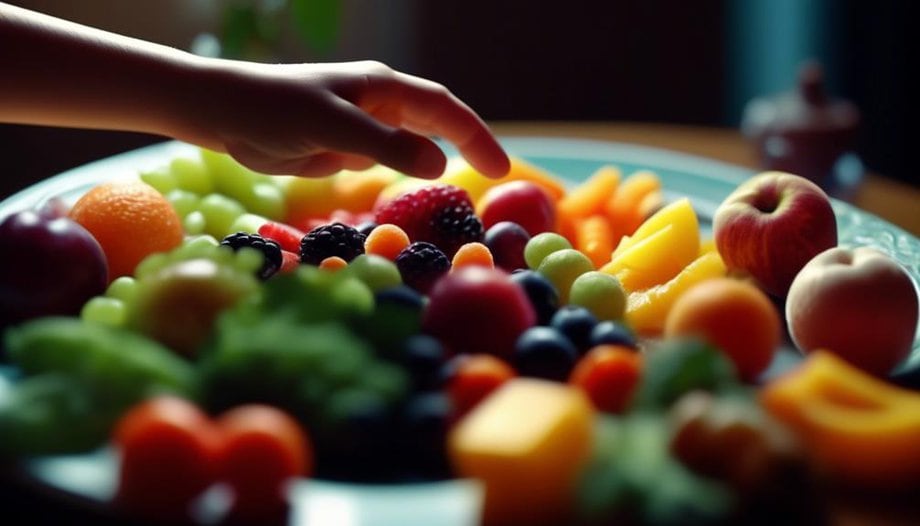When to Start Teaching Kids About Portion Control

The right time to start teaching kids about portion control is from a young age. This sets them up for a lifetime of healthy eating habits and helps prevent overeating.
Strategies for teaching portion control include using visual aids. Using tools like portion control plates or bowls can help children understand what an appropriate portion size looks like.
Modeling healthy habits is another effective way to teach kids about portion control. When children see their parents or caregivers eating balanced meals and practicing portion control, they are more likely to adopt those habits themselves.
Involving children in meal planning and preparation can also help teach them about portion control. By allowing kids to be part of the process, they can learn about portion sizes and make healthier choices.
Overall, starting early and using strategies like visual aids, modeling healthy habits, and involving children in meal planning and preparation can help instill good portion control habits in kids.
Early Introduction to Portion Control
To help your children develop healthy eating habits, it's important to introduce portion control early in their lives. Research shows that starting with a wide variety of age-appropriate foods can encourage balance and moderation. By exposing your children to different types of foods, they can learn to appreciate and enjoy a well-rounded diet.
Teaching children about portion sizes is essential in instilling healthy eating habits. Visual aids and everyday objects can be used to demonstrate appropriate portion sizes. For example, show them that a serving of meat should be about the size of a deck of cards, or that a cup of pasta is roughly the size of a tennis ball. By using relatable objects, children can better understand portion control.
Involving your children in meal planning, grocery shopping, and meal prep can also help them grasp the concept of portion control. Encourage them to choose healthy options and to be conscious of portion sizes. This not only teaches them about balanced eating but also empowers them to make healthier choices on their own.
When discussing portion sizes with your children, it's important to use positive language. Emphasize the importance of listening to their bodies' hunger and fullness cues. Teach them to eat until they're satisfied, rather than encouraging them to clean their plates. This can help them develop a healthy relationship with food and prevent overeating.
Age-Appropriate Strategies for Teaching Portion Control
When it comes to teaching kids about portion control, it's important to introduce age-appropriate strategies that they can easily understand and implement.
One effective approach is to use visual aids and everyday objects to demonstrate serving sizes, such as using a deck of cards to show a serving size of meat.
Encouraging kids to serve themselves using smaller, kid-sized plates can also help them naturally control their portions.
Early Learning Habits
Introduce a variety of healthy foods in appropriate portion sizes to kids at a young age to instill early learning habits of portion control. Here are some age-appropriate strategies for teaching portion control to children:
- Establish a consistent meal schedule: By having set meal times, you can discourage grazing between meals and help children develop a sense of portion control.
- Engage in mealtime experiences: Encourage family dinners where children can witness appropriate portion sizes being served and create positive associations with portion control and eating.
- Educate about portion sizes: Use age-appropriate language and examples to teach children about serving sizes and the importance of balanced nutrition. Help them understand that they don't need to finish everything on their plate.
- Involve children in meal preparation: Allow them to play an active role in meal planning, portioning, and serving. This helps them develop a healthy relationship with food and understand the concept of portion control.
Practical Portion Examples
Want to teach kids about portion control? Here are some practical examples to help them understand appropriate portion sizes. Use hand gestures or common objects to help kids visualize portion sizes, such as showing that 3 ounces of turkey is the size of a deck of cards. Teach kids to recognize serving sizes and servings per container on nutrition facts labels, and help them understand the importance of saving additional servings for later. Show kids that portion control is about eating the right amount, not restricting food, by using measuring cups or bowls to demonstrate appropriate portion sizes. When dining out, ask for a to-go container and divide the meal in half or thirds, teaching kids to serve themselves the appropriate amount and set the extra aside. Serving meals on smaller plates can prevent kids from overeating, so consider using kid-sized plates to make portion sizes easier for them to understand.
| Practical Portion Examples |
|---|
| Use hand gestures or common objects to visualize portion sizes. |
| Teach kids to recognize serving sizes and servings per container. |
| Demonstrate appropriate portion sizes using measuring cups or bowls. |
| Divide meals in half or thirds when dining out. |
| Use smaller plates to prevent overeating. |
Signs That a Child Is Ready to Learn About Portion Control
If your child demonstrates an interest in helping with meal preparation and serving themselves, it may be a sign that they're ready to learn about portion control. Here are some signs that indicate your child is ready to learn about portion control:
- They're able to recognize when they're full and stop eating, showing self-awareness of their own hunger cues. This is a crucial skill as it helps them understand the importance of eating until satisfied, rather than overeating.
- They exhibit an understanding of the difference between healthy and unhealthy food choices. This awareness shows that they're starting to grasp the concept of nourishing their bodies with nutritious foods.
- They show an interest in learning about nutrition and the importance of balanced eating. This curiosity indicates their readiness to delve deeper into the topic of portion control and its role in maintaining a healthy lifestyle.
- They display a willingness to try new foods and portions without resistance or negative behavior. This openness to exploring different foods and adjusting portion sizes is a positive sign that they're receptive to learning about portion control.
Incorporating Portion Control Into Daily Routines
When it comes to teaching kids about portion control, incorporating it into their daily routines is key. Allowing kids to develop a healthy relationship with food starts with understanding appropriate portion sizes.
One practical way to do this is by using smaller plates and bowls. By visually controlling portion sizes, kids can learn to recognize how much food they should be eating.
It's also important to teach kids to read nutrition labels and understand serving sizes. Encourage them to save additional servings for later rather than consuming everything at once. To help kids visualize portion sizes, you can compare them to common objects like a deck of cards or a tennis ball.
Another useful strategy is to have kids serve themselves using measuring cups or bowls. This allows them to learn what an appropriate portion looks like.
When dining out, ask for a to-go container and teach kids to divide their meal in half or thirds. This teaches them the importance of moderation and portion control even when eating out.
Teaching Portion Control Through Visual Aids
When it comes to teaching kids about portion control, visual aids can play a crucial role in helping them understand serving sizes. By using hand gestures or common objects, you can demonstrate the appropriate portion sizes for different foods. For example, showing them that 3 ounces of turkey is the size of a deck of cards or that a serving of nuts is the size of their palm can give them a clear visual reference.
Additionally, using smaller plates when serving meals can help prevent overeating, as research has shown that children tend to serve themselves more food when given adult-sized dishes.
Importance of Visual Aids
Visual aids play a crucial role in teaching children about portion control, helping them understand and recognize appropriate serving sizes. Here are four reasons why visual aids are important in teaching portion control:
- Measuring cups and plates: Using these visual aids can make portion control concepts more tangible and easier for children to understand. They provide a concrete representation of how much they should be eating.
- Hand gestures and common objects: Demonstrating portion sizes with hand gestures and common objects can also help children visualize appropriate serving sizes. For example, showing them that a serving of meat should be about the size of a deck of cards.
- Kid-sized plates: Kid-sized plates and the MyPlate Divided Kids Plate can help children serve themselves appropriate portion sizes and prevent overeating. These plates have sections for different food groups, making it easier for children to create balanced meals.
- Nutrition facts labels: Reading nutrition facts labels together with children can help them learn to recognize serving sizes and servings per container. This empowers them to make informed choices about their eating habits.
Effective Portion Size Examples
To effectively teach children about portion control using visual aids, it is important to provide them with examples of appropriate portion sizes that they can easily understand and relate to. By using familiar objects as visual aids, children can develop a better understanding of how much they should be eating to maintain a healthy diet. Here are some effective portion size examples:
| Food Item | Visual Aid | Portion Size |
|---|---|---|
| Cooked Meat | Deck of Cards | 3 oz. |
| Fruit | Tennis Ball | Medium-sized piece |
| Pancake | CD | Appropriate size |
These visual aids can help children visualize the appropriate portion sizes for different types of food. Additionally, using measuring cups and kid-sized plates can further assist children in understanding and managing portion sizes. By incorporating these examples into your teaching, you can help children develop healthy eating habits and empower them to make nutritious choices when serving meals.
Using Portion Control Tools
You can effectively teach children about portion control through visual aids by utilizing various portion control tools. Here are some tools you can use to help teach kids about portion sizes:
- Measuring cups or bowls: Use these tools to demonstrate appropriate portion sizes. Show children how much food they should be eating by measuring it out in cups or bowls.
- Hand gestures or common objects: Visualize portion sizes by comparing them to hand gestures or common objects. For example, a serving of protein should be about the size of your palm.
- Kid-sized plates or tools: Choose plates or tools specifically designed for kids to help with portion control. The MyPlate Divided Kids Plate is a great option that visually divides the plate into different food groups.
- Nutrition facts labels: Read nutrition facts labels together with children to understand serving sizes and servings per container. This will help them learn how to interpret labels and make healthier choices.
Balancing Portion Control With Healthy Food Choices
Encourage children to develop a healthy relationship with food by teaching them to recognize portion sizes and make balanced, nutritious choices. Balancing portion control with healthy food choices is essential for their overall well-being. To promote balanced nutrition, it's important to encourage a wide variety of healthy foods in age-appropriate portions. Teach children to recognize portion sizes by using visual cues and hand gestures. This will help them develop a healthy understanding of how much food they need to eat.
Emphasize the importance of moderation and not overeating. Use measuring cups and get to-go containers when dining out to manage portion sizes effectively. Involving children in meal prep and grocery shopping can make them more aware of portion sizes and healthy food choices. This hands-on approach will empower them to make better decisions in the future.
Communication is key when teaching kids about portion control. Use clear and positive language to convey portion sizes. Help them understand and accept limits by explaining the importance of balance and moderation in their diet.
Long-Term Benefits of Teaching Kids About Portion Control
Teaching kids about portion control can have long-term benefits for their overall health and well-being. Here are four reasons why incorporating this practice into their meals is so important:
- Foster a Healthy Relationship with Food:
By teaching kids about portion control, you're instilling in them a sense of balance and moderation when it comes to eating. This healthy relationship with food can last a lifetime and help them make informed choices about what and how much they eat.
- Maintain a Healthy Weight:
Children who learn about portion control are more likely to maintain a healthy weight as they grow older. By understanding appropriate portion sizes, they can avoid overeating and the associated health issues that can arise from excess weight.
- Reduce the Risk of Overeating:
Understanding portion control from a young age can reduce the risk of overeating and the development of unhealthy eating habits in adulthood. By learning to listen to their bodies and eat appropriate amounts, kids can avoid the negative consequences of overindulgence.
- Develop Independence in Food Choices:
Kids who grasp portion control early are better equipped to make balanced food choices and manage their eating habits independently. This skill is crucial for their overall wellness and helps them develop positive dietary behaviors that will benefit them throughout their lives.
Frequently Asked Questions
How Do I Teach My Child Portion Control?
Want to teach your child about portion control? Start by modeling healthy eating habits. Encourage mindful eating by serving appropriate portion sizes and avoiding unnecessary distractions. Involve your child in meal planning and preparation to foster a positive relationship with food.
How Do You Introduce a Portion Size to a Child?
To introduce portion sizes to a child, make it fun! Create visual aids like using a deck of cards for meat or a tennis ball for fruit. Play games and use measuring cups to teach them about appropriate portions.
How Much Portion Control for a 1 Year Old?
You should serve small portion sizes for a 1-year-old, about the size of their palm or fist. Offer a variety of healthy foods in small portions to encourage good eating habits. Use measuring cups and visual aids to guide portion sizes.
Should You Portion Control a Toddler?
You should portion control a toddler to promote healthy eating habits and teach them about balanced meals. It helps them develop portion awareness and a positive relationship with food from a young age.











